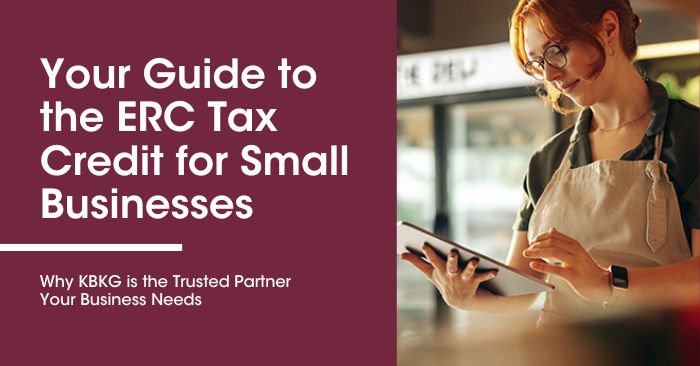Your Guide to the ERC Tax Credit for Small Businesses
Thought Leadership by KBKG
During the tumultuous years of the pandemic, many companies had to make tough choices, including whether or not to keep all of their staff members. To protect jobs, the federal government created incentives, including the ERC (or ERTC) tax credit, to help companies keep their workers. Eligible businesses can get money back for keeping people employed. Keep reading to see how the program works and what it can mean for you.
Table of Contents:
What Is the ERC Tax Credit?
So, what is the Employee Retention Credit? It’s a federal tax credit that encourages businesses to retain their employees during times of economic hardship, such as during a crisis or a recession. As part of the Coronavirus Aid, Relief and Economic Security (CARES) Act in 2020, this tax credit was one of many measures to help businesses during unprecedented times.
The Consolidated Appropriations Act of 2021 and the American Rescue Plan Act of 2021 modified and extended the ERC. Businesses were eligible based on their staffing levels between March 12, 2020, and January 1, 2022.
Why Was the Employee Retention Credit Put in Place?
The goal of the ERC was to help businesses avoid layoffs and furloughs, which would have had a negative impact on the economy. The credit also helped to keep employees connected to their jobs and their communities. By offering tax relief to businesses that continue to pay wages to their staff, the government aimed to stabilize the labor market, reduce unemployment and encourage the economy to recover quickly.
How Much Can Employers Receive From the ERC Tax Credit?
The program evolved throughout the pandemic to ensure that it helped business owners in the way that they needed. Therefore, the payouts changed between different years. The amount of wages paid to employees determines the amount of the ERC that an employer can claim. For 2020, the ERC is 50% of up to $10,000 in wages paid and certain healthcare benefit costs per employee. This means an employer could claim up to $5,000 per employee in 2020.
The Employee Retention Credit 2021 rules are a bit different. For that year, the ERC is 70% of up to $10,000 in wages paid and certain healthcare benefit costs per employee per quarter, increasing the amount of money a business could claim.
What Are the Qualifications To Claim the Credit?
The goal of the ERC tax credit was to incentivize businesses that protected jobs, so the credit is not available to everyone. To qualify for the Employee Retention Credit in 2020 and 2021, a business must meet the following criteria:
- The business must have experienced a significant decline in gross receipts due to the COVID-19 pandemic.
- The business must have kept employees on the payroll during the pandemic.
- The business must have paid wages to employees during the pandemic.
Companies that qualified as recovery startup businesses in the third or fourth quarters of 2021 can also apply to receive the tax credit. If your business used the Paycheck Protection Program but didn’t claim the Employee Retention Credit, you may be able to qualify retroactively for 2020 and 2021. To see how this works, let the certified public accountants at KBKG review your situation to determine if you are eligible for an employee retention tax credit.
KBKG is providing the following services to assist with ERC:
-
- Determine if the employer qualifies, and if so, for which quarters,
- Determine which employee wages qualify
- Calculate credits, including analysis of PPP interplay, and
- Reconcile actual credits with advance credits requested
- Prepare reconciled data for Form 941-X
- Prepare documentation supporting a business’ qualifications
Can the ERC Tax Credit Help Your Company?
Most businesses can’t afford to leave money unclaimed, but that’s exactly what you may be doing if you haven’t looked into whether your company qualifies for the ERC tax credit program. If your business survived the pandemic while protecting jobs and keeping the community strong, you may be able to get money back that you can reinvest into your company. Get in touch with KBKG today and start exploring your options.
https://www.irs.gov/newsroom/employee-retention-credit-2020-vs-2021-comparison-chart
Curious to know more about the ERC credit? Contact us today.
Related Pages
-
Employee Retention Tax Credit – Benefit Estimate
-
Where is My Employee Retention Credit Refund?
-
KBKG Tax Insight: IRS warns Taxpayers of Improper Employee Retention Credit Claims and ERC Mills
-
KBKG Tax Insight: IRS To Target Abusive ERTC Claims. Analysis of Government Shutdown & Supply Chain Rules
-
It’s Not Too Late to Claim Employee Retention Tax Credits
-
The Employee Retention Tax Credit (ERC): What Small Businesses Need to Know


